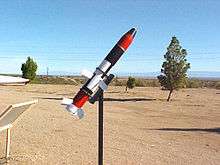M712 Copperhead

The M712 Copperhead is a 155 mm caliber cannon-launched, fin-stabilized, terminally laser guided, explosive shell intended to engage hard point targets such as tanks, self-propelled howitzers or other high-value targets. It may be fired from different artillery pieces, such as the M114, M109, M198, M777 and CAESAR howitzers. The projectile has a minimum range of 3 km and a maximum range of 16 km.[1]
Description
At 62.4 kilograms (137.6 lb) and 140 centimetres (54 in) long, Copperhead is longer and heavier than traditional 155mm ammunition.[2]
The warhead assembly consist of a shaped charge loaded with 6.69 kilograms (14.75 lb) of Composition B.
For Copperhead to function, the target must be illuminated with a laser designator. Once the laser signal is detected, the on-board guidance system will operate the steering vanes to maneuver the projectile to the target. The Copperhead targeting logic is designed to (1) ensure that the optical system will always be able to detect the target, and (2) that once the target has been detected there will be sufficient time and velocity to maneuver to hit the target. Copperhead must be below any cloud cover at critical parts of the trajectory, and there must be sufficient visibility to ensure that when the target is acquired the projectile will have sufficient time to maneuver.
Modes of operation
Copperhead has two modes of operation: Ballistic mode and glide mode. Ballistic mode is used where the cloud ceiling is high and visibility is good. When the projectile is 3,000 meters from the target, the guidance vanes extend, the target is acquired, and then the on-board guidance system adjusts the guidance vanes to maneuver onto the target.
Glide mode is used when the cloud ceiling and/or the visibility is too low to permit the use of the ballistic mode. A glide mode trajectory consists of two phases: a ballistic phase and a glide phase. At a predetermined point along the trajectory, the guidance vanes extend and there is a transition from ballistic phase to glide phase. Glide phase targeting logic is designed to ensure the largest possible angle of fall permitted by the cloud cover and the visibility. The target is acquired when the projectile is close enough to detect the laser illumination or when the projectile emerges from the cloud cover, whichever event occurs later in the trajectory. When a trajectory solution has been obtained, time-to-target and terminal velocity are checked to ensure that there will be enough time to maneuver and that the projectile is aerodynamically stable—that it will not stall while maneuvering.
Initially the laser designation was intended to be performed by the MQM-105 Aquila pilotless drone.[3]
Combat history
Copperhead was used in Operation Desert Storm,[4] with 90 rounds fired against hardened targets.[1] It was also used in the 2003 Operation Iraqi Freedom.
Operators

Current operators
Former operators
-
 Australian Army[5] – now replaced by SMArt 155
Australian Army[5] – now replaced by SMArt 155
References
- 1 2 Ripley, Tim. The new illustrated guide to the modern US Army. Salamander Books Ltd. pp. 114–115. ISBN 0-86101-671-8.
- ↑ http://www.ausairpower.net/SP/DT-SPH-0705.pdf
- ↑ p.43, Yenne & Yenne
- ↑ M712 Copperhead - Global Security
- ↑ "DEFENCE PURCHASES NEW ANTI-TANK ARTILLERY ROUND". Australian Department of Defence. Retrieved 9 December 2010.
Sources
- Yenne, William, Yenne, Bill, Attack of the Drones: A History of Unmanned Aerial Combat, Zenith Imprint, 2004 ISBN 0-7603-1825-5